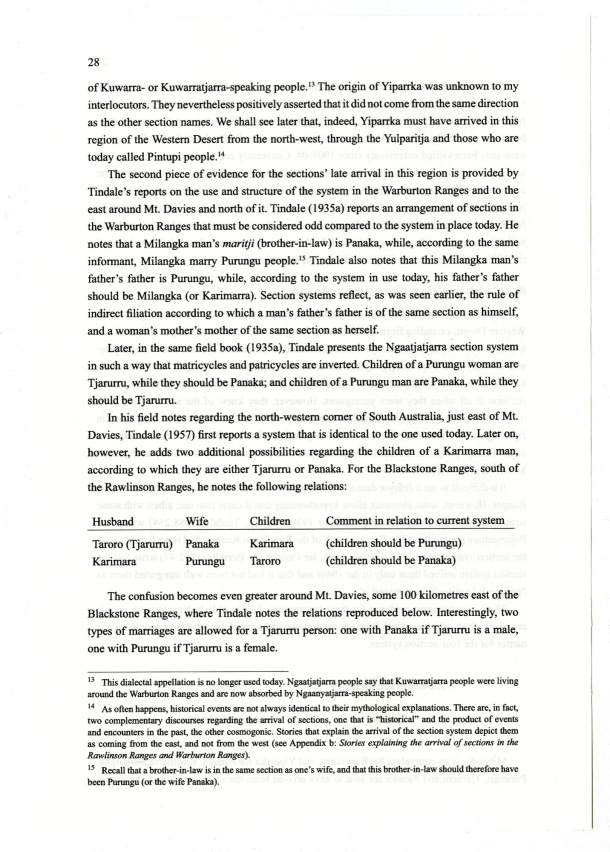|
| 
[Note: this transcription was produced by an automatic OCR engine]
28
of Kuwarra- or Kuwarratjarra—speaking people.” The origin of Yiparrka was unknown to my
interlocutors. They nevertheless positively asserted that it did not come from the same direction
as the other section names. We shall see later that, indeed, Yiparrka must have arrived in this
region of the Western Desert from the north-west, through the Yulparitja and those who are
today called Pintupi people.“
The second piece of evidence for the sections’ late arrival in this region is provided by
Tindale’s reports on the use and structure of the system in the Warburton Ranges and to the
east around Mt. Davies and north of it. Tindale 193Sa reports an arrangement of sections in
the Warburton Ranges that must be considered odd compared to the system in place today. He
notes that a Milangka man’s maritji brother-in—law is Panaka, while, according to the same
informant, Milangka marry Puningu people.” Tindale also notes that this Milangka mau’s
father’s father is Purungu, while, according to the system in use today, his father’s father
should be Milangka or Karimatra. Section systems reflect, as was seen earlier, the rule of
indirect filiation according to which a ma.n’s father’s father is of the same section as himself,
and a woman’s mother’s mother of the same section as herself.
Later, in the same field book l935a, Tindale presents the Ngaatjatjarra section system
in such a way that matricycles and patricycles are inverted. Children of a Purungu woman are
Tjarurrn, while they shorfld be Panaka; and children of a Pumngu man are Panaka, while they
should be Tjarurru.
In his field notes regarding the ncrth—western comer of South Australia, just east of Mt.
Davies, Tindale 1957 first reports a system that is identical to the one used today. Later on,
however, he adds two additional possibilities regarding the children of a Karimarra man,
according to which they are either Tjarurru or Panaka. For the Blackstone Ranges, south of
the Rawlinson Ranges, he notes the following relations:
Husband Wife Children Comment in relation to current system
Taroro Tjarurru Panaka Karimara children should be Purungu
Karimara Purungu Taroro children should be Panaka
The confusion becomes even greater around Mt. Davies, some 100 kilometres east of the
Blackstone Ranges, where Tindale notes the relations reproduced below. Interestingly, two
types of marriages are allowed for a Tjarurru person: one with Panaka if Tjarurru is a male,
one with Purungu if Tjarurru is a female.
13 This dialectal appellation is no longer used today. Ngaatjatjana people say that Kuwan-atjan-a people were living
around the Warhurton Ranges and are now absorbed hy Ngaanyatjarn-speakin people.
1‘ As ofien happens, historical events are not always identical to their mythological explanations, There are, in fact,
two complementary discourses regarding the arrival of sections, one that is “historical” and the product of events
and encounters in the past, the other cosrnogonic. Stories that explain the arrival of the section system depict them
as coming from the east, and not fiom the west see Appendix b: Stories explaining the arrival of sections in the
Rawlinsan Ranges and Warburron Ranges.
‘5 Recall that a brother-in-law is in the same section as one‘s wife, and that this brother-in-l should therefore have
been Purungu or the wife Panaka.
|